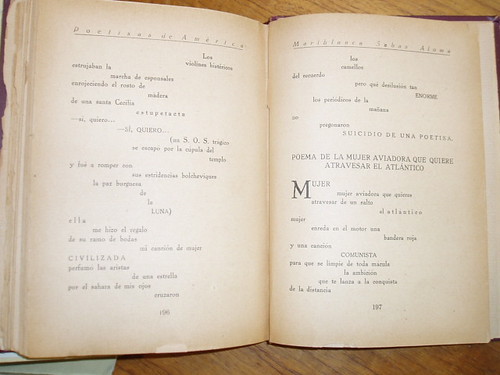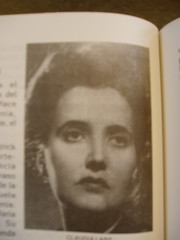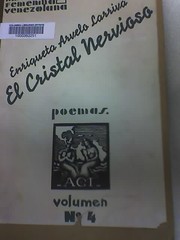Translation: Mariblanca Sábas Alomá
Mariblanca Sábas Alomá (1901–1983)
Mariblanca Sábas Alomá was an Ultraist feminist Cuban writer. She was involved with the first Congreso Nacional de Mujeres in Havana in 1923. Her work was published in El Cubano Libre, Diario de Cuba, Orto and El Sol in Havana. Sábas Alomá took literature courses in Mexico and also attended Colombia University in New York and Puerto Rico. She travelled throughout South America, worked as a journalist and editor, and was politically active as a communist and feminist.
In Poetisas de América, Sábas Alomá’s contemporary María Monvel, with characteristic blunt opinion, says of her:
Mariblanca comenzó escribiendo versos blancos, soñodores, llenos de ritmo, musicalidad y vulgaridad. Mariblanca cambió de filas, se pulió, se cultivó, y hoy hace campear su estandarte en las filas del más refinado ultraismo. Poeta de las revoluciones, como la uruguaya Blanca Luz Brum, Don Quijote de las ilusiones extremas, Mariblanca se ha convertido como en broma, en una notable poetisa. Es de esperar que cuando aconche un poco su absolutismo izquierdista, Mariblanca será una de las grandes poetisas americanas. (193)
Mariblanca began writing poetry that was pretty, sonorous, full of rhythm, musicality and vulgarity. Mariblanca changed her tune, became refined, cultivated, and today has raised her banner in the ranks of the most savvy ultraists. Poet of revolutions, like the Uruguayan Blanca Luz Brum, a Don Quixote of extreme illusions, Mariblanca has converted herself from a trivial writer into a notable poetess. It’s to be hoped that when her absolutist leftism settles, Mariblanca will be one of the greatest American poetesses.
Sabás Alomá’s 1920 article “Masculinismo, no. Feminismo!” was published recently in a volume of her essays, Feminismo. In 1928 she published an article in which she characterized lesbianism (“garzonismo”) as a crime against nature, encouraged by capitalism, that would disappear with the advent of true socialism; for her, feminism was in complete opposition to lesbianism (Menéndez).
Magda Portal wrote critical articles about the socially engaged vanguardist poetry of Sabas Aloma in a 1928 issue of Repertorio americano, “El nuevo poéma y su orientación hacia una estética económica” (Unruh, Performing, 176).
In “Poema a una mujer aviadora,” Sábas Alomá spaces words freely across the page, leaping great distances in sweeping arcs, just as the aviator would zig-zag across the Atlantic. A later poet, the Argentine writer Elvira Hernández, might be paying homage to Sábas Alomá in her long poem “Carta de viaje,” both in form and in theme. Hernández describes a flight across the Atlantic from south to north, from Latin America to Northern Europe, focusing on the dislocated state of flying, not on land, sea, or earth, detatched from terrestrial metaphor.
Juana de Ibarbourou echoes the “shout” of Sabás Alomá in her 1930 poems “El grito,” “Las olas,” and “Atlántico” in which she longs to leap the distance between the world of the real and the world of ideals.
Poema de la mujer aviadora que quiere atravesar el Atlántico
MUJER
mujer aviadora que quieres
atravesar dee un salto
el a t l á n t i c o
mujer
vereda en el motor una
bandera roja
y una canción
COMUNISTA
para que se limpie de toda macula
la ambición
que te lanza a la conquista
de la distancia
enorme
mujer
no asciendas por coqueteria
asciende porque el clamor intenso da
los hombres que sufren
t e p r e s t e s u s a l a s
mujer
tiende sobre la vastedad marina
que
S
E
P
A
R
A
dos continentes
el arco fraternal que una en un mismo
anhelo de
J U S T I C I A
a América
y a
Europa
mujer
desde una altura de 2,000 metros
deja caer sobre el mar
y sobre la tierra
L A N U E V A P A L A B R A
así veremos en la noche
un zig
zag
guiar
d e e s t r e l l a s j u b i l o s a s
mujer
esconde en la cabina de tu aeropleno el
G R I T O
– santo–y–seña de la América joven –
A N T I M P E R I A L I S M O
y clávalo
– para que toda Europa lo contemple
y
los ejércitos de
RUSIA
le hagan los saludos de ordenanza
EN LO MÁS ALTO DE LA TORRE DE EIFFEL
mujer
si tu sueño se rompe en el canto de una ola
no llegues a los dominios de lo
desconocido
rezando–padre nuestro, que estás
en los cielos
–sino regalando el oído
de los proletarios exámines
con un
– ARRIBA LOS POBRES DEL MUNDO
DE PIE LOS ESCLAVOS SIN PAN . . .
Poem of the aviator woman who would cross the Atlantic
WOMAN
woman aviator who wants
to cross in one bound
t h e a t l a n t i c
woman
in the engine falling into step with a
red flag
and a song that's
COMMUNIST
in order to cleanse everything soiled from
the ambition
that throws you at the conquest
of distance
enormous
woman
you don't ascend through coquetry
you ascend because the intense clamor of
people who suffer
l e n d s y o u w i n g s
woman
you stretch above the marine vastness
that
S
E
P
A
R
A
T
E
S
two continents
the fraternal arch that in the same
longing for
JUSTICE
for America
and for
Europe
woman
from a height of 2,000 meters
let fall across the sea
and across the land
T H E N E W W O R D
so that we'll see it in the night
a zig
zag
trail
o f j u b i l a n t c o n s t e l l a t i o n s
woman
hidden in the cabin of your airplane is the
S H O U T
– sacred–and–signal of the young America–
A N T I M P E R I A L I S T
and drive it home
– so that all Europe will see it
and
the multitudes of
RUSSIA
will make their comradely greetings the norm
ON THE HIGHEST PEAK OF THE EIFFEL TOWER
woman
if your dream breaks on the song of a wave
you won't arrive at the domains of what's
undiscovered
praying–our father, who art
in heaven
– not conforming to the rule
of the watchful proletariats
with a
RISE UP, POOR OF THE EARTH
STAND UP, SLAVES WITHOUT BREAD . . .




